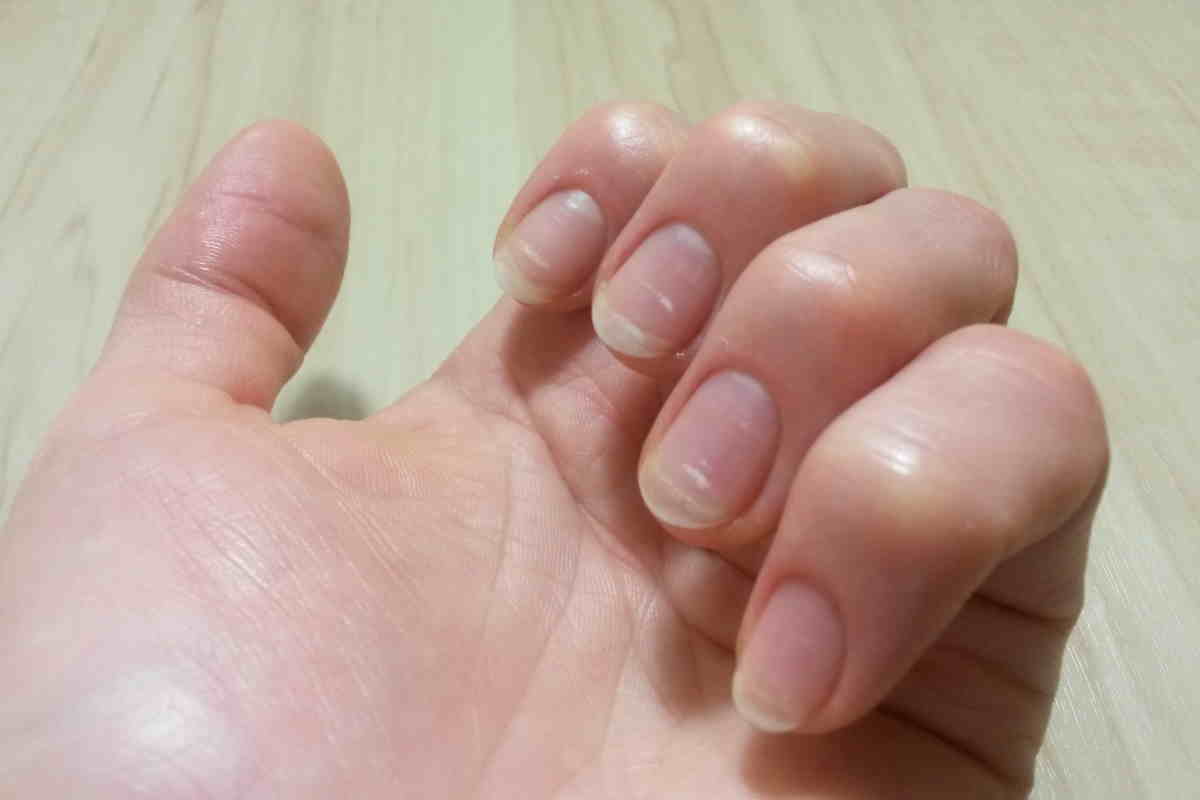Abnormalities in the shape, color, general appearance of the nails can be very useful clues to discover hidden diseases or identify any nutrient deficiencies
@bussa/123rf.com
We nibble them when we are stressed or nervous, we cut them very short or on the contrary we let them grow to the limits of discomfort, we hide them (if all goes well) with chemical enamels or (if it goes badly) with real “prostheses” that do not other than damaging them. Yet nails are a very important part of our body, and they can provide us with a lot of information about our health … if only we let them speak!
In fact, even small anomalies in the external appearance of our nails can be a symptom of pathologies and health problems, even serious ones. Think that Hippocrates of Kos, in the fifth century BC, was already observing the state of health of the nails and fingers of his patients to diagnose systemic diseases. This is why attention to the nails should be part of a correct and complete dermatological control.
Let’s try to better understand what clues our nails can give us about our state of health and the possible presence of pathologies.
Abnormalities of the nail shape
Coilonichia
Literally, the term means “spoon nail” and describes the presence of an anomalous curvature that gives the nail a concave appearance: in practice, the nail surface is so hollow that it can hold a few drops of water inside. This phenomenon occurs for both fingernails and toenails.
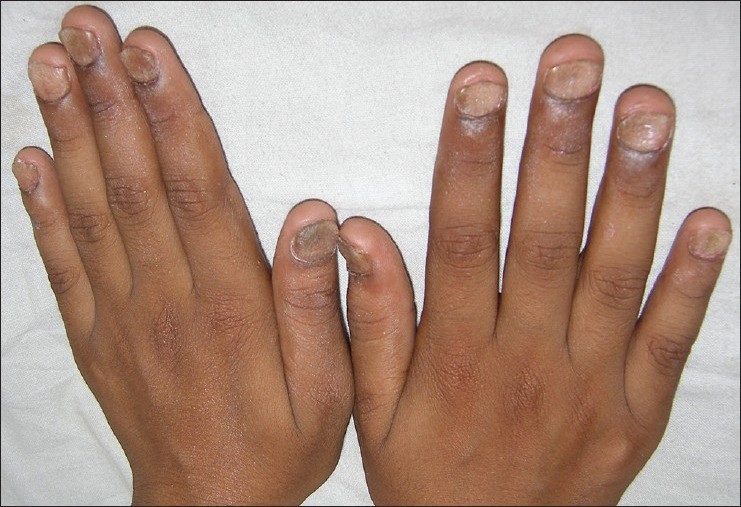
©National Library of Medicine
This nail condition can be associated with many physical conditions – from iron deficiency to malnutrition, from coronary heart disease to malignant tumors of the upper gastrointestinal tract. However, do not worry if we observe it in our small child: in newborns and infants it is a rather common condition, which tends to disappear after the first years of life.
Clubbing
Phenomenon already studied by Hippocrates (which is why it is also defined digital hippocratism), clubbing indicates greater curvature of the nail plate with soft tissue hypertrophy of the digital pulp usually involving both fingers and toes.
Generally associated with congenital heart disease, respiratory problems (metastatic lung cancer, lung abscesses, cystic fibrosis), and inflammatory bowel disease, clubbing can also be an early sign of AIDS in HIV-positive pediatric patients.
Pincer nail
Basically, it is the ingrown nail: both sides of the nail grow towards the inside of the flesh, creating pressure and pain, while the center curves upwards. The phenomenon can occur as a consequence of the use of unsuitable shoes or a bad cut of the nail itself, but the hereditary component can also play a role in the manifestation of the problem.
(Read also: Ingrown toenail: causes and natural remedies)
Doliconichia e brachionichia
These are two opposite problems. In the first case, the length of the nail plate is much greater than the width, and this can be a consequence of hypopituitarism (reduced functionality of the pituitary gland which has among its consequences also short stature, infertility, cold intolerance, fatigue and absence of milk secretion).
In the case of brachionichia, however, the nail plate is unusually wide and short: this can be a consequence ofhyperparathyroidism (excessive production of parathyroid hormones) or psoriatic arthropathy (a form of chronic inflammatory arthropathy associated with skin and nail psoriasis).
Macronichia e micronichia
Also in these two cases, it is a question of anomalies in the size of the nails: in the case of macronichia (consequence of the gigantism) the nail will be larger than normal, while in the case of micronichia (which often occurs in association with the neurofibroma) the nail will be excessively small. These two phenomena can occur in all nails or even in one of the fingers.
Nail attachment abnormalities
Onycholysis
The term refers to the detachment of the nail from the nail bed. The phenomenon is frequently associated with various conditions – such as trauma, psoriasis, fungal attacks or allergic reactions to nail polishes and other types of nail cosmetics. Rarely, onycholysis is associated with systemic diseases (anemia, skin leukemia, diabetes mellitus, thyroid disorders, lupus erythematosus, vitamin C deficiency).
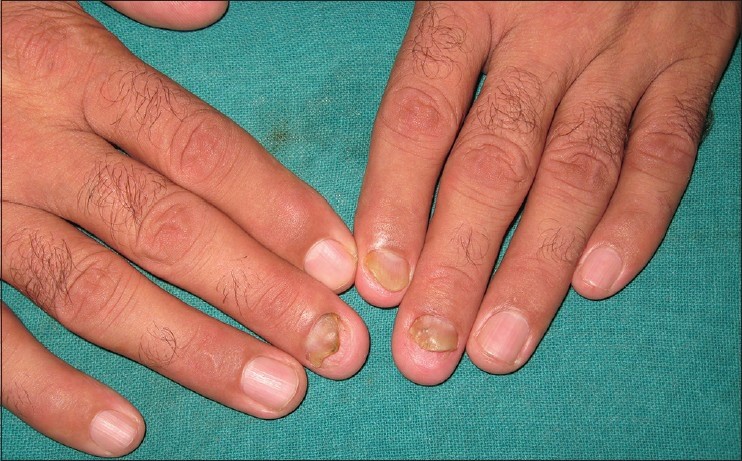
©National Library of Medicine
Pterygio
It is a form of nail dystrophy caused by a scar involving the nail fold and extending to the base of the nail (cuticle): it can be one dorsalwhen the nail fold merges with the matrix and the nail bed, or ventralif the nail fold is no longer visible.
The first case of pterygium is also the most widespread and occurs as a consequence of trauma, burns, dyskeratosis congenita and Lupus. Ventral pterygium, on the other hand, manifests itself in the presence of leprosy, neurofibromatosis and systemic sclerosis. Either way, it can involve one or more fingernails and toenails.
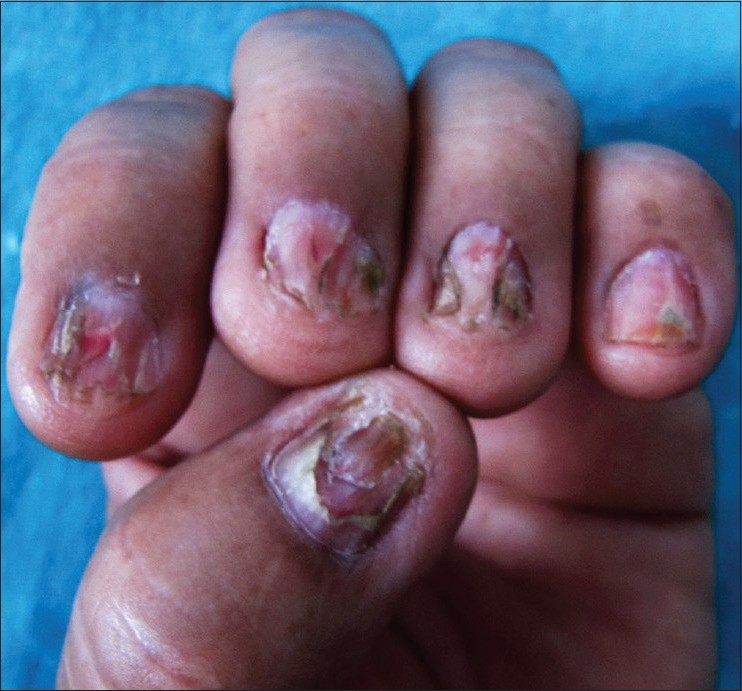
©National Library of Medicine
Abnormalities of the nail surface
Longitudinal swelling (onicorrhesis)
Despite the unusual name that many of us have never heard of, onychorressi is a rather widespread anomaly, which can be ascribed to several causes: it is an alteration of the nail plate, which appears thinned, with longitudinal streaks, brittle and therefore easily subject to flaking or chipping.
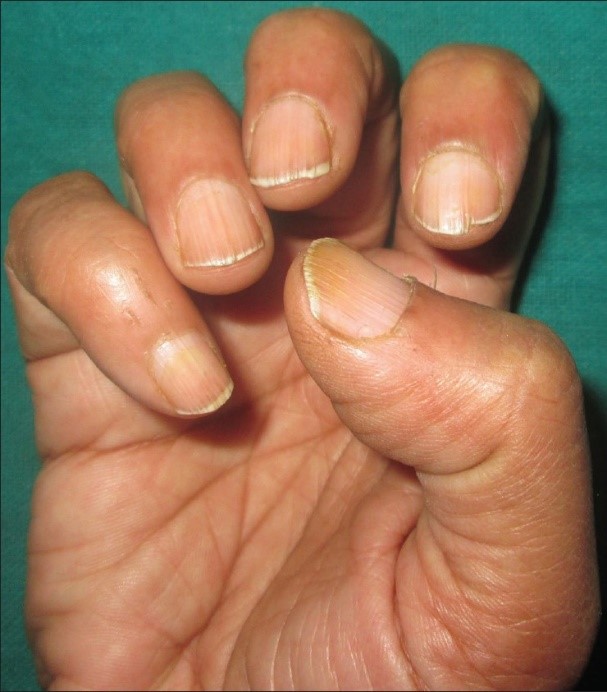
©National Library of Medicine
If the problem affects only one nail, it is likely that the cause is a slight trauma or a bump. If, on the other hand, we notice vertical streaks and weakness in all the nails, it is likely that it is a lack of iron, folic acid or protein – in this case we suggest that we refer our nail health observation to the family doctor, who will be able to advise them. clinical tests more suitable to determine any deficiency in progress.
Lines of Beau
Also in this case we find ourselves in the presence of a rather widespread problem: Beau’s lines appear as horizontal furrows that cross the nail from one side to the other, sometimes characterized by a more whitish color than the color of the nail. In the past, our mothers and grandmothers attributed the appearance of these grooves to a lack of calcium in the nails, but this is an urban legend – especially since the nails are not made up of calcium, but of keratin!
The causes behind this disorder are numerous: they range from physical trauma to psychological stress, from fever to hypothermia up to malnutrition. In severe cases, if the growth of the nail is completely inhibited by the presence of Beau’s lines, the nail itself will fall off (onychomadesis).

©National Library of Medicine
Nail pitting (trachyonichia)
The so-called pitting it is characterized by the presence of tiny depressions along the entire surface of the nail – a sort of “holes” that make the surface of the nail similar to a tailor’s thimble. The diagnostic utility of this symptom is not very consistent, since there are too many pathologies that can be linked to this manifestation (psoriasis, syphilis, arthritis, dermatomyositis … just to name a few).
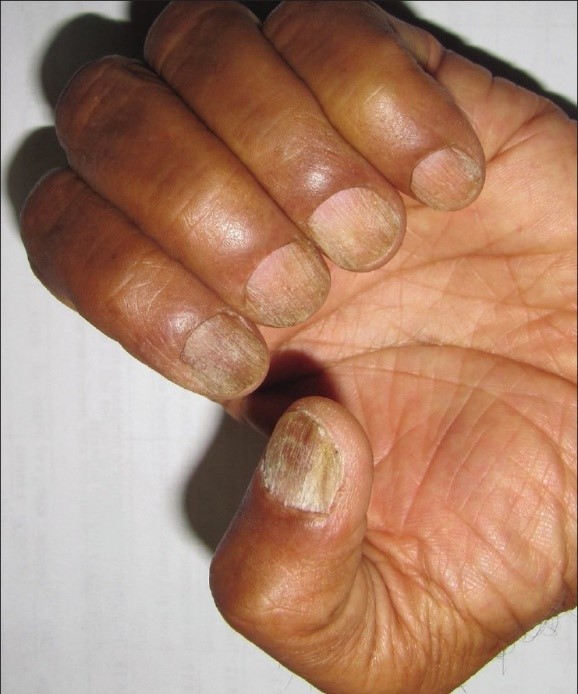
©National Library of Medicine
Nail color abnormalities
Leuconichia
Leukonychia is a condition characterized by total or partial discoloration of the nail plate: it usually manifests itself with horizontal white spots or strips, but can involve the entire nail.
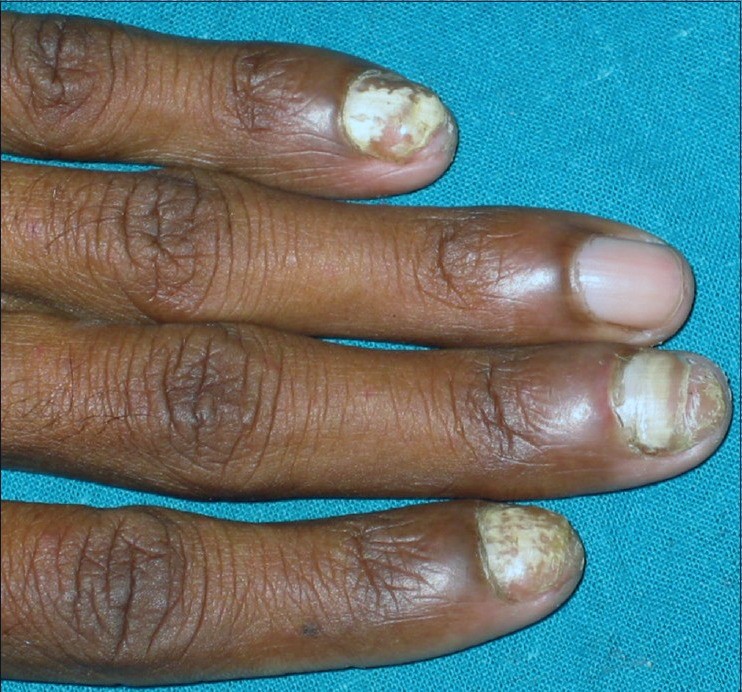
©National Library of Medicine
The scientific literature identifies three types of leukonychia:
- Mees lines. Characterized by single or multiple whitish lines running from one part of the nail to the other and affecting several fingers, this leukonychia is linked to conditions such as leprosy, tuberculosis, malaria, herpes zoster, chemotherapy drugs, kidney and heart failure. , pneumonia.
- Muehrcke lines. They usually present with a whitish double line, possibly resulting from an edematous state localized in the nail bed that exerts pressure on the vascular bed. They are manifestations of an albumin deficiency and disappear when this protein value normalizes. Muehrcke’s lines are observed in the presence of nephrotic syndrome, liver pathologies, following the use of chemotherapy drugs and in case of malnutrition.
- Lindsay’s nail. It is a leukonychia that occurs with half of the nail with normal color and the other half (the outermost one) characterized by an abnormal brownish color. It is observed in patients with renal uremic insufficiency.
Melanonichia
Melanonychia is nothing more than an anomalous bluish-black color that affects a longitudinal band of the nail (or, in some cases, the entire nail surface). The causes that can give rise to this pigmentation include some inflammatory skin diseases, the use of drugs (including antimalarials, minocycline, phenytoin, psoralens) and systemic diseases. Even smoking, the presence of thyroid or HIV pathologies, the advanced age of the subjects can contribute to the appearance of the phenomenon.
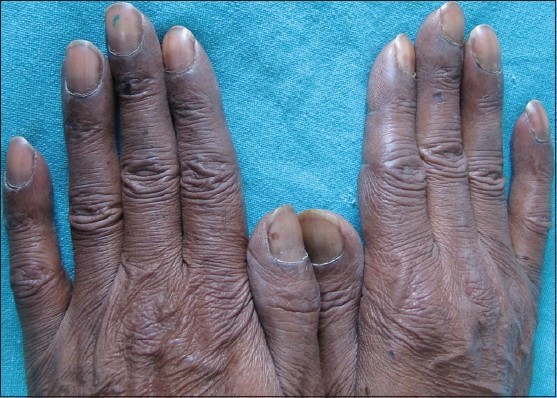
©National Library of Medicine
Telangiectasia of the nail bed
Telangiectasias are enlargements of the blood vessels that can occur inside the soft organs (such as the brain or intestine) but also under the skin, in more or less extensive forms. These are mostly harmless enlargements, but often a symptom of other more serious and important diseases such as diabetes mellitus and rheumatoid arthritis, or a sign of rare diseases such as THE e HHT.
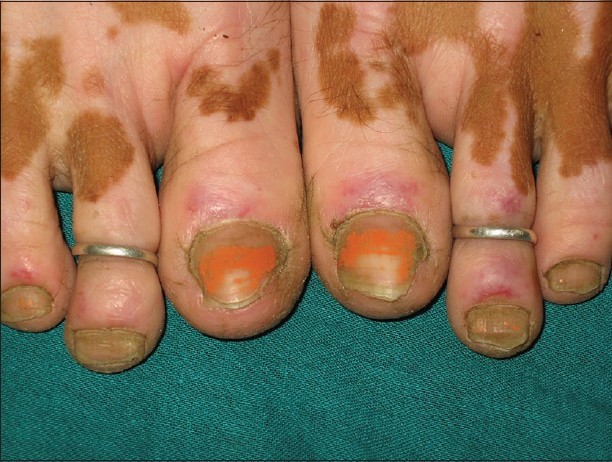
©National Library of Medicine
Yellow nail syndrome
It is a thickening of the nail, which takes on a yellow tending to green color. Also in this case, the causes of this disorder can be multiple and are usually connected to a malfunction of the respiratory system (impaired breathing due to pleural effusion) or of the lymphatic system (lymphedema).
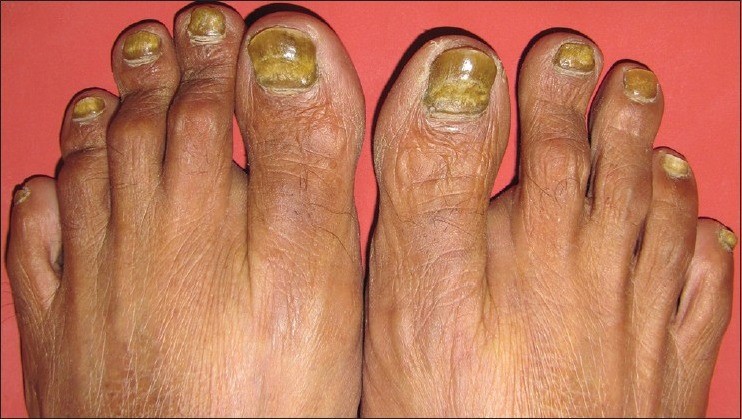
©National Library of Medicine
Even heavy smokers can witness a yellowing of their nails which can be connected in the first place to the deposition of nicotine from cigarettes, but which can also represent a hidden symptom of respiratory system diseases related to smoking, such as lung cancer. Finally, in the most severe cases of jaundice, the yellowish discoloration of the mucous membranes can extend to involve the nails, which thus become a mirror of the health of our liver.
Follow your Telegram | Instagram | Facebook | TikTok | Youtube
Fonte: National Library of Medicine
We also recommend:
